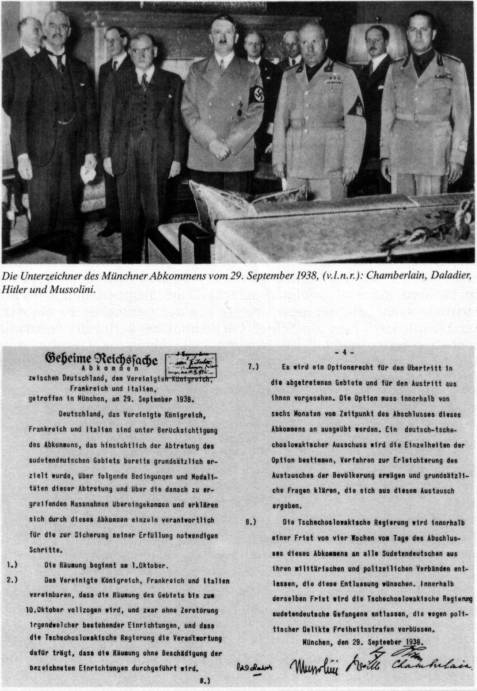|
18.
The amalgamation with Germany
On
September 12, 1938, Hitler declared at the Reichsparteitag (party
rally) in Nuremberg: "The poor Palestinians are
defenseless and perhaps they are forlorn. The Germans in
Czechoslovakia are neither defenseless nor forlorn. This
should be taken into consideration". On September 25,
1938, Lord Runciman, special mediator appointed by the British
Government for the Czechoslovakian controversy, wrote to the
Prime Minister: "… Czechoslovak rule in the Sudeten
areas for the last twenty years … has been marked by
tactlessness, lack of understanding, petty intolerance, and
discrimination, to a point where the resentment of the German
population was inevitably moving in the direction of revolt.
… A very large majority of their inhabitants desire
amalgamation with Germany." On September 15, Henlein
addressed the Sudetengermans in a broadcast on German radio:
"Without ever relinquishing our demand for autonomy, we
did our utmost with great sacrifices to sustain our livelihood
in the Czech state. All our efforts for a just settlement have
been in vain. We want to live as a free German people! We
desire that peace and employment return to our homeland! We
want to go home to the Reich!" Wenzel Jaksch, chairman of
the German Social-Democratic Party of Czechoslovakia, made a
final appeal: "Sudetengermans! You all must now make the
decision: Equality through peace or extinction through war …
Take heed: decide for the peaceful course!"
Towards
the end of 1938 the move was on Henlein with his Sudetengerman
Party and Hitler with his National-Socialists. On September
22, Czechoslovakia proclaimed mobilization. 1½ million
soldiers stood under arms. Five days later, all
radio-receivers were confiscated, 20,000 Sudetengermans taken
hostage, more than two-hundred bridges blown up, long
stretches of railroad made useless, tunnels blasted. On
September 29, the Munich-Agreement was signed.

On
October 30, Hitler proclaimed creation of the "Reichsgau
Sudetenland" (district of Germany) with administration in
Reichenberg, and the incorporation of southern regions of
Bohemia and Moravia to districts of Bavaria and Austria, and
of the "Hultschiner Ländchen" to Silesia. Henlein
was installed as "Gauleiter" (head-administrator) of
the Sudetengau. The Reichsgesetz (country-wide law) of
November 21, states: "The amalgamated Sudetengerman
regions are constituent parts of the German Reich." On
the same day, the international committee declared the
Munich-Agreement as being fulfilled since the stipulations had
been met.
And
what came after the entry of the German Military? From October
to December of 1938 as many as 2,500 Sudetengermans were taken
to the concentration camp of Dachau alone. Altogether about
20,000 arrests and "relocations" took place.
Approximately 30,000 Sudetengermans emigrated to the West.
Hence the year 1938 did not exult in jubilation alone; deep
concerns and soberness took hold. In March of 1939 Hitler took
possession of the remaining parts of Bohemia and Moravia,
thereby depriving the Czech people of their freedom and
independence in violation of the law for self-determination on
which he had pleaded for the Sudetengermans. He established
the "Protectorate Bohemia and Moravia".
|